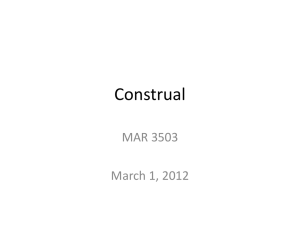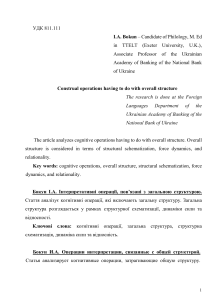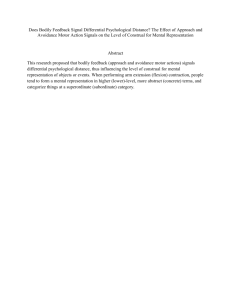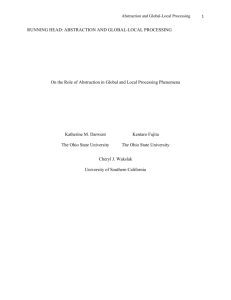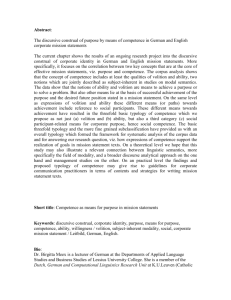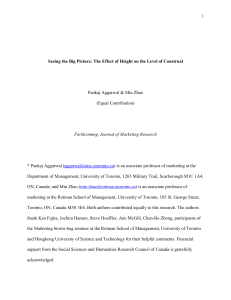NEW DIRECTIONS IN LEXICAL SEMANTICS:
advertisement
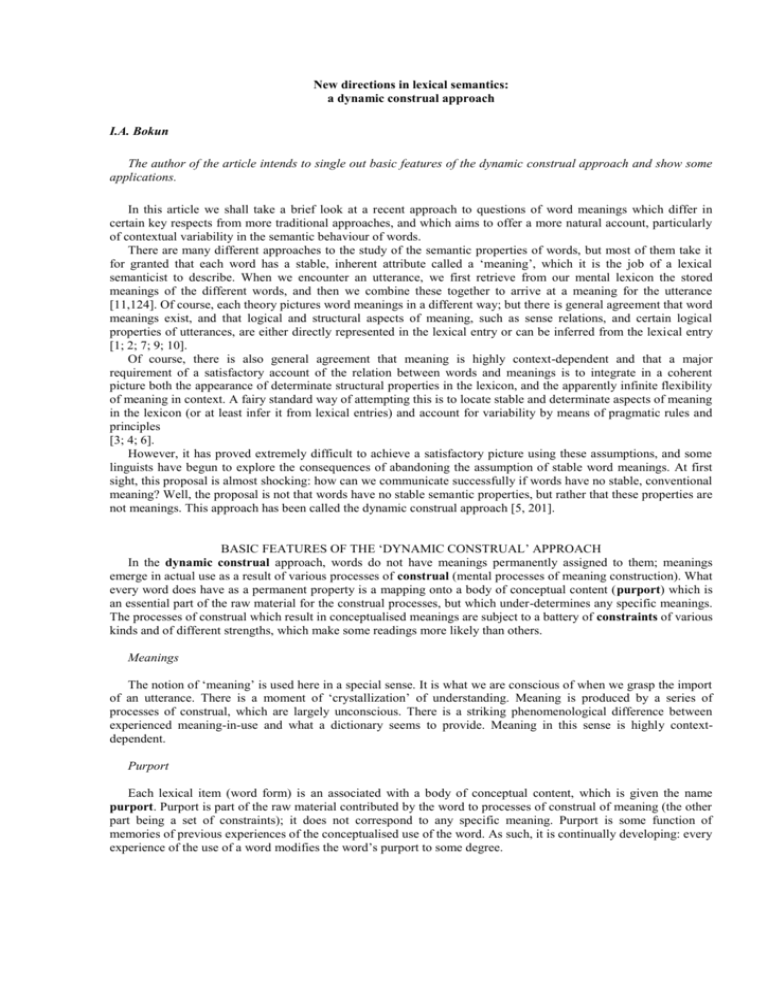
New directions in lexical semantics: a dynamic construal approach I.A. Bokun The author of the article intends to single out basic features of the dynamic construal approach and show some applications. In this article we shall take a brief look at a recent approach to questions of word meanings which differ in certain key respects from more traditional approaches, and which aims to offer a more natural account, particularly of contextual variability in the semantic behaviour of words. There are many different approaches to the study of the semantic properties of words, but most of them take it for granted that each word has a stable, inherent attribute called a ‘meaning’, which it is the job of a lexical semanticist to describe. When we encounter an utterance, we first retrieve from our mental lexicon the stored meanings of the different words, and then we combine these together to arrive at a meaning for the utterance [11,124]. Of course, each theory pictures word meanings in a different way; but there is general agreement that word meanings exist, and that logical and structural aspects of meaning, such as sense relations, and certain logical properties of utterances, are either directly represented in the lexical entry or can be inferred from the lexical entry [1; 2; 7; 9; 10]. Of course, there is also general agreement that meaning is highly context-dependent and that a major requirement of a satisfactory account of the relation between words and meanings is to integrate in a coherent picture both the appearance of determinate structural properties in the lexicon, and the apparently infinite flexibility of meaning in context. A fairy standard way of attempting this is to locate stable and determinate aspects of meaning in the lexicon (or at least infer it from lexical entries) and account for variability by means of pragmatic rules and principles [3; 4; 6]. However, it has proved extremely difficult to achieve a satisfactory picture using these assumptions, and some linguists have begun to explore the consequences of abandoning the assumption of stable word meanings. At first sight, this proposal is almost shocking: how can we communicate successfully if words have no stable, conventional meaning? Well, the proposal is not that words have no stable semantic properties, but rather that these properties are not meanings. This approach has been called the dynamic construal approach [5, 201]. BASIC FEATURES OF THE ‘DYNAMIC CONSTRUAL’ APPROACH In the dynamic construal approach, words do not have meanings permanently assigned to them; meanings emerge in actual use as a result of various processes of construal (mental processes of meaning construction). What every word does have as a permanent property is a mapping onto a body of conceptual content (purport) which is an essential part of the raw material for the construal processes, but which under-determines any specific meanings. The processes of construal which result in conceptualised meanings are subject to a battery of constraints of various kinds and of different strengths, which make some readings more likely than others. Meanings The notion of ‘meaning’ is used here in a special sense. It is what we are conscious of when we grasp the import of an utterance. There is a moment of ‘crystallization’ of understanding. Meaning is produced by a series of processes of construal, which are largely unconscious. There is a striking phenomenological difference between experienced meaning-in-use and what a dictionary seems to provide. Meaning in this sense is highly contextdependent. Purport Each lexical item (word form) is an associated with a body of conceptual content, which is given the name purport. Purport is part of the raw material contributed by the word to processes of construal of meaning (the other part being a set of constraints); it does not correspond to any specific meaning. Purport is some function of memories of previous experiences of the conceptualised use of the word. As such, it is continually developing: every experience of the use of a word modifies the word’s purport to some degree. Construal Construal, as it is understood here, is the process of constructing a meaning, using purport as raw material, subject to a battery of constrains. There are many types of construal, and the full process may well comprise several distinct stages. A full account of construal types is not possible here, but some idea of the processes involved can be gleaned from a consideration of the following example: (I) The ball struck Pete full on the face, and he suffered a broken nose and some bruising. First of all, the word ball maps onto what can be considered to be two distinct regions of purport, corresponding roughly to “round object” and “social function”. It is extremely difficult to construe these as a single unity (due to cognitive, ‘reality’, and conventional constraints), and therefore one of them will normally be selected as being relevant: that is to say, a certain region of the purport of ball will be selected, and other parts will play no further part in the construal process. The occurrence of struck Pete in the face in the linguistic context of ball will probably be sufficient to select the “round object” reading of ball, but this will almost certainly be reinforced by features of the situational context of the utterance. However, this is not the end of the process, because there are many different types of ball, and the consequences of being struck on the face differ greatly according to the type involved (think of a child’s rubber ball and a cricket ball). Hence a more restrictive construal of ball is needed; this, too, will depend on a combination of contextual and conventional constraints. On the basis of this information, some representation of an individual ball must then be construed. How detailed this representation is will depend largely on contextual factors: for instance, if the hearer did not actually witness the event, the representation may well be very sketchy. Context will also influence the highlighting of certain features of the ball at the expense of others: in the case of being struck on the face, the ball’s weight, velocity, and hardness are likely to figure prominently (but not, for instance, its colour or price). Some aspects of the final construal will also depend (assuming that some game was in progress at the time of the incident) on whether Pete was a player, a spectator, or a passer-by. Notice that a similar type of meaning construction will be necessary for struck (the picture of being struck is very different for a tennis player striking a ball, say and a car striking a lamp post), and for broken (a broken nose is different in many respects from a broken windowpane). Constraints Of course, we are not free to construe an utterance in whatever way our fancy dictates (otherwise communication would be virtually impossible): there are pressures, of various strengths and types, to interpret in particular ways. Some constraints are very basic - for instance, the way the word is, and the ways in which our minds work. Besides these, two types of constraint which have particular relevance to language may be singled out: conventional constraints contextual constraints. Conventional constraints Conventional constraints - how the society in which we live habitually uses words, construes situations, and so on - are absolutely crucial to the functioning of language as a communicative system. There are two aspects of convention: one is the mapping between word forms and purports; the other is how the mapped-onto purport is construed. Certain construals because they are so frequent and so stable across contexts, become subject to very strong constraints and will acquire a special default status; and extra cognitive effort, or a strong countervailing constraint, will be required to impose a different interpretation. Context Conventional constraints are a major source of semantic stability, but this exists alongside a high degree of contextual variability. This variability affects all aspects of meaning, from basic structural and logical properties to the subtlest nuances. Many features of context can affect construal: (i) linguistic context: This includes previous discourse, i.e. what has been said immediately prior to a given utterance, and a word’s immediate linguistic environment (i.e. the phrase or sentence in which it appears). (ii) physical context: What the participants can see, hear, and so on in their immediate situation. (iii) cognitive context: Speakers have an enormous store of knowledge and remembered experiences which forms a background against which utterances are processed (some of this will be presumed to be shared with the hearer), and which can affect how a word is construed. (iv) type of discourse: For instance, a word may well be construed differently according to whether it occurs in a poem, a medical consultation, a casual conversation or a police interrogation. The construal will also be sensitive to whether the situation is formal or informal, and what the field of discourse is (for instance, whether it is legal, political, medical or sporting, etc.). (v) relations between communicants: Construal may well depend on what the social and power relations are between utterer and addressee, and on what they think and feel about one another. Some applications of the dynamic construal approach In principle, the dynamic construal approach applies to all aspects of word meaning. It will be illustrated here in connection with the construal of sense boundaries, the construal of category boundaries and sense relations of inclusion and exclusion, and the construal of oppositeness. Lexical ambiguity and the construal of sense boundaries The possession of more than one sense is traditionally regarded as an inherent property of particular words, to be represented in the mental lexicon (and in any satisfactory dictionary). In the dynamic construal approach, sense boundaries are construed in context on particular occasions of use, subject to a range of constraints. Of course, with some words conventional constraints will be so strong that same boundary will be construed on the vast majority of occasions of use. There may be some justification in regarding these as ‘default’ construals. Obviously, the less scope there is for context to influence construal in particular instances, the less difference there will be between the dynamic construal approach and the traditional approach. However, two important points should be made: first, probably no conventional constraint is so strong that it can never be overruled; second, the strength of conventional constraints is a significant variable, and many sense boundary effects are clearly dependent on context. This overall picture is more satisfactorily captured by a notion of dynamic construal with conventional constraints of varying strength: confining the study of word meaning to cases where there is a clear default reading seriously distorts the resulting picture. A typical case of traditional lexical ambiguity is bank, with the two meanings “financial institution” and “margin of river”. These two readings are so strongly supported by conventional constraints that it is extremely difficult to find contexts in which they are not distinct. However, it is not impossible. Take example (2): (2) Not all banks are money banks. To achieve a normal construal of (2) we have to interpret it as something like “Not all entities designated by the phonological form /bank/ are financial institutions”; in other words it requires a conceptual shift to a metalinguistic perspective. Examples like this have been used to argue that the zeugma test for ambiguity is not valid. But this objection rests on the assumption that a word found to be ambiguous in one context must be ambiguous in all contexts. No such assumption is made in the dynamic construal approach; indeed, from our point of view, the absence of zeugma correctly indicates that banks in 1 is not ambiguous. However, the fact that a unified reading for bank is possible in only a very restricted range of contexts is a sign that there are very strong constraints favouring a ‘split’ reading. Variable construals of sense boundaries are well illustrated by facets and microsenses. There are, for instance, two facets of book, namely [TOME] and [TEXT], illustrated by a green book and a difficult book, respectively. There are uses of book in which a sense boundary is clearly detectable; see, for instance, the ambiguity of (3a) and (3b): (3) a. two books; b. a new book. (3a) can designate either two copies of the same text (i.e. two applies only to ‘tomes’) or two texts (which may, in fact, be contained within a single ‘tome’, as in two books in one); a new book may be a new copy of a very ancient text, or a copy (whether in pristine condition or not) of a recently published text. In an appropriate context, a question containing (3b) can be truthfully answered both in the affirmative and the negative, that is to say, responses can be relative to one facet to the exclusion of the other. Consider (4): (4) Is that a new book? It is not difficult to imagine a context where this question has two contradictory answers, both of them true. As a final example, in both (5) and (6) one of the facets (a different one in each case) is isolated from the other by a construed sense boundary: (5) Don’t tell me about the plot or the writing, tell me about the book itself. ([TEXT] excluded); (6) Don’t tell me about the cover design or the illustrations, etc., tell me about the book itself. ([TOME] excluded). It may seem that nothing is lost by saying that book ‘has’ two facets as part of its inherent semantic nature. However, there are also contexts where there is apparently no trace of a boundary between the facets of book, although their ‘content’ is present: (7) books and other publications; (8) They are planning to publish a book on the subject. This is difficult to explain if the boundary is an inherent part of the meaning of book, but receives a natural account if the boundary is construed in some contexts but not others. A similar picture emerges in the case of microsenses. For instance, for Tom’s first answer in (9) to be logically well-formed (which it is), a sense boundary has to be construed separating tennis balls and footballs: (9) Tom (who has a football under his arm): Hey, let’s play tennis. Billy: You got a ball? Tom: (i) No. (ii) Yeah, but not a tennis ball. But his second answer (also perfectly well-formed) requires no boundary to be construed. The crucial part of the context affecting boundary construal here is whether Tom prefaces his reply with Yes or No. Notice that the awkward question of whether book and ball are ambiguous or not does not arise if we adopt the dynamic construal approach, where sense boundaries are the result of particular construals in context. The notion of contextually construed sense boundaries can also be applied to semantic features like the [MALE] of “stallion”. Instead of saying that the meaning of the word stallion ‘consists of’ the feature [MALE] plus the feature [EQUINE] (or whatever), we can say that in certain contexts (for instance That’s not a stallion), a sense boundary is construed which isolates the meaning “male” for compositional purposes. Taking this view, we would not expect stallion to exhibit a semantically compositional nature in all contexts. The construal of category boundaries We have been looking at boundaries between meanings. But the construal of a boundary can also be thought of in extensional terms, as a way of drawing a line between things that are in a category and things that are not. There has been a tendency to assume that words are associated with stable categories. However, it is an essential feature of the dynamic construal approach that, just as words are not associated with specific meanings, nor are they associated with specific conceptual categories, but with bodies of purport which allow variable construal in different contexts. Take the example of the category PET in English. One can find electronic devices, which behave in certain ways like animals: these are sometimes referred to as cyberpets. If we ask whether these objects belong to the category PET, some people will answer Yes, and others No. This can be taken to indicate that different speakers construe the categories in different ways. But suppose we ask the question in (9): (10) Is a cyberpet a real pet? This time the majority respond No, because the word real causes the position of the category boundary to be construed differently. On the other hand, an educational psychologist consulted by the parents of a difficult child might say: (11) I would advise you to get her some kind of pet, perhaps even an electronic one. This will seem normal to most people, even though pet is used to include the electronic variety: some kind of and even cause a broader category to be construed. Another example is (12): (12) A cat has four legs. Few will dispute the truth of this, even though there is nothing illogical about the notion of a three-legged cat. It seems that when we interpret (11), we construe the category of cats in such a way that only perfectly formed examples are counted. A different construal of the boundaries of the category of cats is illustrated in (13): (13) Cats are vertebrates. The word vertebrate is a technical term, and this makes us construe a category appropriate to scientific discourse, which includes three-legged cats. Consider also (14): (14) I wish I could fly like a bird. The word bird here requires us to construe a category, which excludes not only injured birds but also flightless birds. Notice that on the dynamic construal view, the question of which is the ‘true’ category denoted by cat or bird, or whatever, has no sense: the purport that the word maps onto is neutral between all the possible construals. Boundary placement can be seen as an example of the operation of Lakoff’s ‘container’ image-schema [8, 13]. Clearly, the position of category boundaries has a determining effect on sense relations such as hyponymy and incompatibility: if the category denoted by word W 1 falls wholly within the boundaries of the category denoted by W2, then W1 will be hyponymous to W2, and if the category denoted by W 2 and the category denoted by W3 have no members in common, then W 2 and W3 will be incompatibles. But the variability in associated categories which we have observed entails that sense relations, too, are subject to construal in context, rather than being stable properties of lexical items. Take the case of hyponymy. Two diagnostic tests for hyponymy are first, entailment - the fact that It’s a cat unilaterally entails It’s an animal indicates that cat is a hyponym of animal, and second, normality in the frame Xs and other Ys, as in cats and other animals. However, there is an awkward discrepancy between the two tests: cats and other pets is fine, but It’s a cat does not, in most people judgement, entail It’s a pet. So, is cat a hyponym of pet or not? Taking a dynamic construal view, there is no problem: cat is a hyponym of pet in cats and other pets, but not in It’s a cat therefore it is a pet, and the difference is due to the fact that the construed categories are different in the two contexts. A similar story can be told about incompatibility. In All sorts of people have used our services, students, nuns, housewives, doctors …, we are encouraged to construe the coordinated categories as mutually exclusive (and therefore to construe the terms as incompatibles). But the categories construed in X is a nun, therefore she is not a student, are such that statement is not logically valid. The dynamic construal view does not exclude the possibility that some construals have a default status, that is, they are the interpretations that will emerge if there is not enough context to guide the process of construal. Notice that this is not the same as saying that these are real, inherent meanings of words - they still have to be construed. There is, however, some uncertainty as to the criteria for deciding which readings are to be given the status of defaults. Some might feel that the reading of cat in It’s a cat therefore it is an animal should be taken as the default. But why should this be? This is a rather artificial context, most people will think of the domestic variety, which would point to the construal in cats and other pets as the default. The construal of opposites In most treatments of oppositeness, words are assigned to specific types of opposite. For instance, dead : alive are described as complementaries, and long : short as polar antonyms. However, the field of semantic oppositeness provides further examples of structural properties that are context-dependent, and hence a more satisfactory picture is obtained if relations such as antonymy and complementarity are regarded as holding between construals subject to constraints. Antonyms vs. complementaries Some opposite pairs behave in some contexts like a pair of complementaries (contradictories) and in other contexts like a pair of antonyms (gradable contraries). A typical example is safe : dangerous. Complementaries are recognized by the fact that negating them entails the assertion of the opposite. Most speakers will infer from (15) that it is dangerous to use the path in question at night: (15) It’s not safe to go along that path at night. However, (16) shows safe and dangerous behaving like gradable antonyms: (16) It used to be quite dangerous, but it’s a lot safer now that they’ve installed proper lightning. There is a small number of opposites that behave like safe and dangerous in that they display an unusual freedom in respect of construal type. In many cases there is evidence of conventional or cognitive constraints favouring one construal or the other. Take the case of dead : alive. With these a complementary construal is probably the favoured one: (17) A: Is it dead? B: No, look, it’s breathing - it’s still alive. However, in an appropriate context alive can behave like one member of a pair of gradable antonyms: (18) You look a bit more alive than you did yesterday! (Interestingly, this is not so easy with dead: (19) ?You look a bit more dead than you did yesterday!) The pair married : single show an even stronger constraint favouring a complementary construal: (20) Are you married or single? However, in one of Iris Murdoch’s novels we find (20): (21) Jane was very married. This presents no problems of interpretation, but most speakers probably feel that the conventions of English are being stretched. Direction of scale Graded properties are usually construed in such a way that more of them is more salient, so, for instance, it is more natural to think of a scale of length than a scale of shortness. The fact that we have a scale of length correlates with the fact that How long is it? (rather than How short is it?) is the normal, neutral question for enquiring as to the linear extent of something. However, there are contexts where a construed scale seems to go in the ‘wrong’ direction. For instance, (22) appeared in a newspaper article about the miniaturisation of computer components: (22) The new device is ten times smaller than anything seen previously. And (23), in the same context, seems normal: (23) A: Every week we produce smaller and smaller chips. B: How small do you think you’ll be able to get them? In these examples, the scale of size is being construed as a scale of SMALLNESS rather than the more usual scale of BIGNESS/LARGENESS, and B’s question in (23) is function as a neutral question. This reversal goes against quite strong cognitive constraints, and would not be possible unless there were special situational features. What licenses the reversal in this case is probably the ‘smaller-is-better’ nature of the enterprise. Effect of calibration Graded properties are normally construed in such a way that whether there is a standard way of measuring them can make a difference to the semantic behaviour of a word denoting the property. Take the case of strong: (24) John prefers his beer and his tea to be on the strong side. (24) is quite normal, showing that we use the same construal of strong for beer and tea. But there is a marked difference in normality between (25) and (26). this is because we can easily think of a way of measuring the strength of beer (for instance, the percentage of alcohol), but we do not normally assign a measurement to the strength of tea: (25) What is the strength of this beer? (26) ? What is the strength of this tea? The situation is similar in the case of hard. There is a scientific scale for expressing the hardness of minerals, so the question What is the hardness of topaz? is normal in a scientific context. However, we have no readily available units for measuring the hardness of wood, so the question What is the hardness of teak? is somewhat peculiar. To sum up, the dynamic construal approach treats meanings and structural semantic properties such as sense and category boundaries, scale schemas, and sense relations like hyponymy as ‘on-line’ construals on occasions of use, and not as inherent properties of lexical items. This approach has a number of advantages: (i) We are encouraged to give up the search for the ‘real’, ‘basic’, ‘underlying’ meaning of words: this search has not produced impressive results. On the dynamic construal approach, there is no such thing. (ii) We have an explanation for the vast intuitive gulf between our vivid experience of living, situated meaning and what we get when we pick a word out of a dictionary. The dynamic construal approach brings lexical semantics much closer to actual language use. (iii) The descriptions of sense relations and other structural properties of word meanings is greatly simplified. For instance, hyponymy and incompatibility can be given a simple logical characterization, there being no need for dubious notions like the ‘para-hyponymy’ and ‘para-incompatibility’ which were found necessary in Cruse (5) to characterize the relations between dog and pet, and nun and student, respectively. (iv) The dynamic construal approach can account equally well for context-dependent and relatively context-independent properties. Context-dependent properties are problematic for an approach that seeks to assign inherent semantic properties to lexical items. However, cases where properties appear relatively invariant under context change are no problem for the dynamic construal approach, because construal is subject to a range of constraints of different strengths, some of which are relatively transient and others of which, such as cognitive and conventional constraints, are relatively stable. Hence, the construal-and-constraints approach offers a more comprehensive account. At the same time, the dynamic construal approach undoubtedly raises a number of questions. For instance, the exact nature of both purport and resultant construed meanings is in need of clarification - traditional semantics does not help us much here. Another question concerns the status of a conventional dictionary in this view. No one can deny the usefulness of dictionaries; but if words do not have stable meanings, what does a dictionary record? One possibility is that the main function of a dictionary definition is to locate the body of conceptual content (the purport) to which the word being defined gives access. In some cases, a picture or diagram can do this more efficiently than a verbal definition. A dictionary cannot list all possible readings/construals, not even all autonomous ones, but our innate competence in construal can construct these if the appropriate purport is known. There is currently no definitive answer to these and many other questions, but ongoing research will undoubtedly bring fresh insights. REFERENCES 1. 2. 3. 4. 5. 6. 7. 8. 9. 10. 11. Asher R.E., Simpson J.M.Y. The Encyclopaedia of Language and Linguistics. - Oxford: Pergamon Press, 1994. – 445 p. Blakemore D. Semantic Constraints on Relevance. Oxford: Blackwell, 1987. 274 p. Blackemore D. Understanding Utterances: An Introduction to Pragmatics. - Oxford: Blackwell, 1992. – 376 p. Carston R. Thoughts and Utterances: The pragmatics of Explicit Communication. - Oxford: Blackwell, 2002. – 244 p. Cruse D.A. Lexical Semantics. - Cambridge University Press, 1986. – 178 p. Cruse A. Meaning in Language: an Introduction to Semantics and Pragmatics. - 2-ed. - Oxford: Oxford University Press, 1995. – 441 p. Dillon G.L. Introduction to Contemporary Linguistic Semantics. - New York: Holt, Rinehart and Winston, 1979. – 203 p. Lakoff Y., Johnson M. Metaphors We Live By. - Chicago: Chicago University Press, 1980. – 273 p. Kearns K. Semantics. - London: Macmillan, 2000. – 338 p. Keith A. Linguistic Meaning. London: Routledge and Kegan Paul, 1986. 273 p. Pustejovsky J. The Generative Lexicon. Cambridge Mass.: MIT Press, 1995. 217 p. – – –
